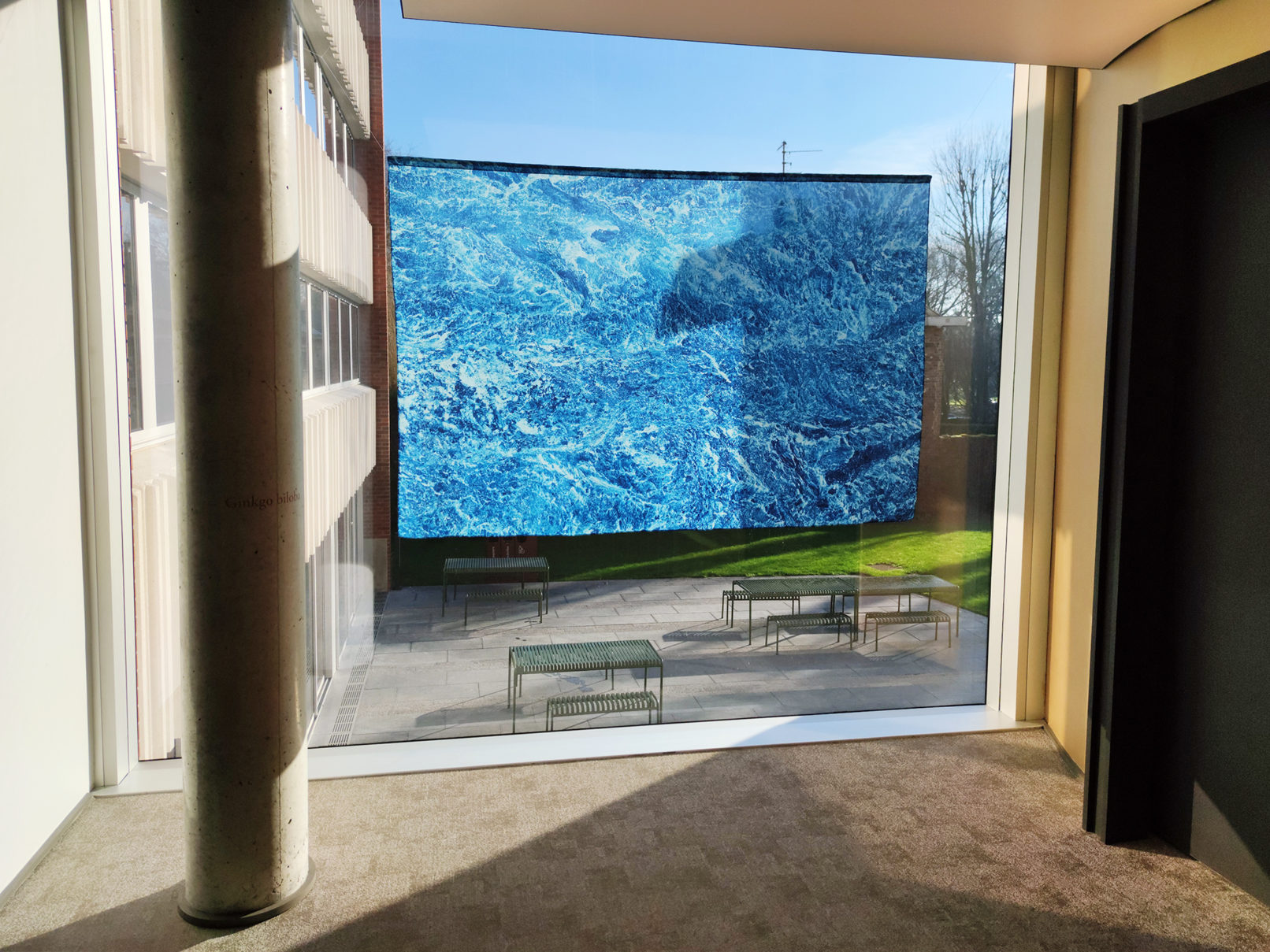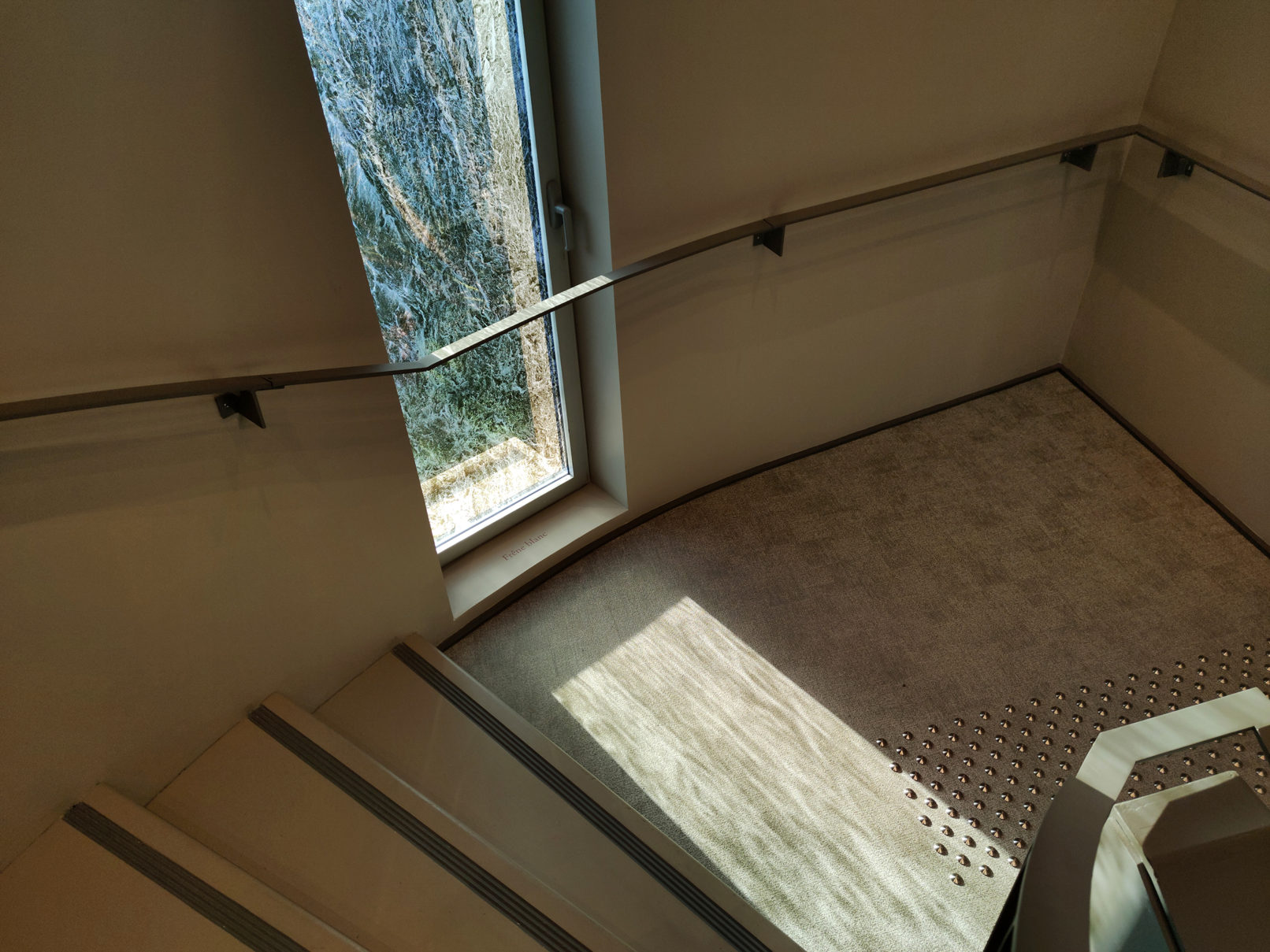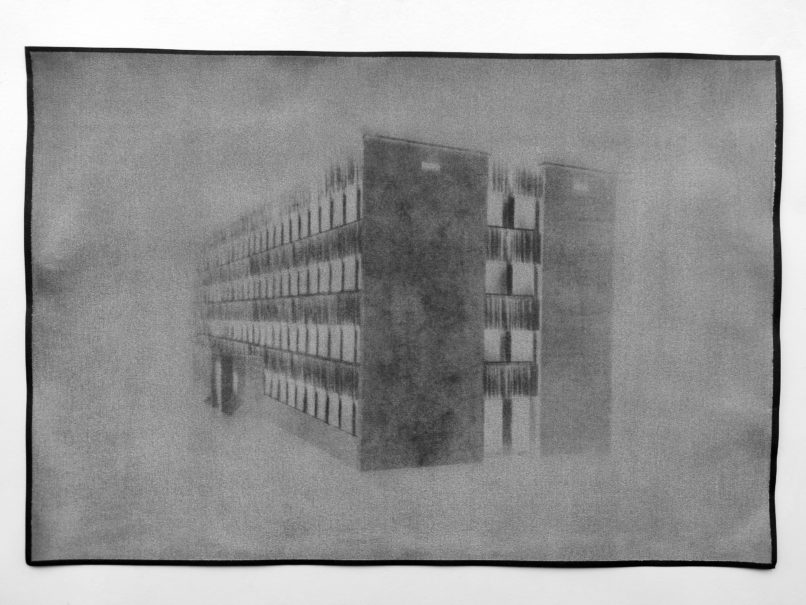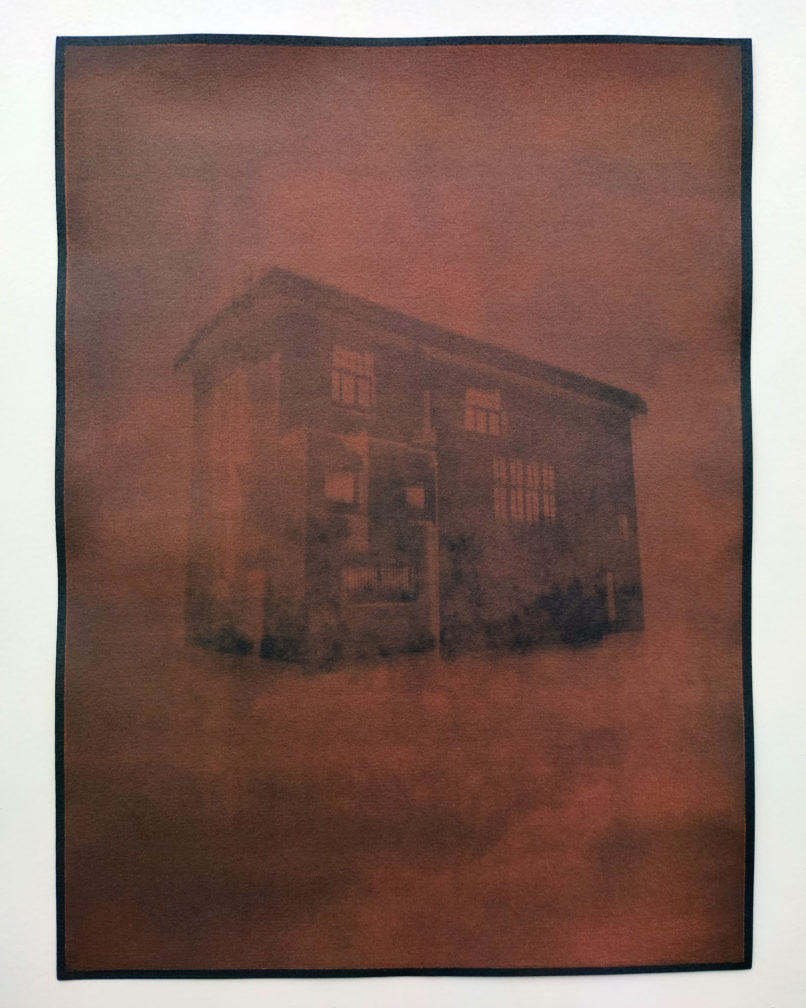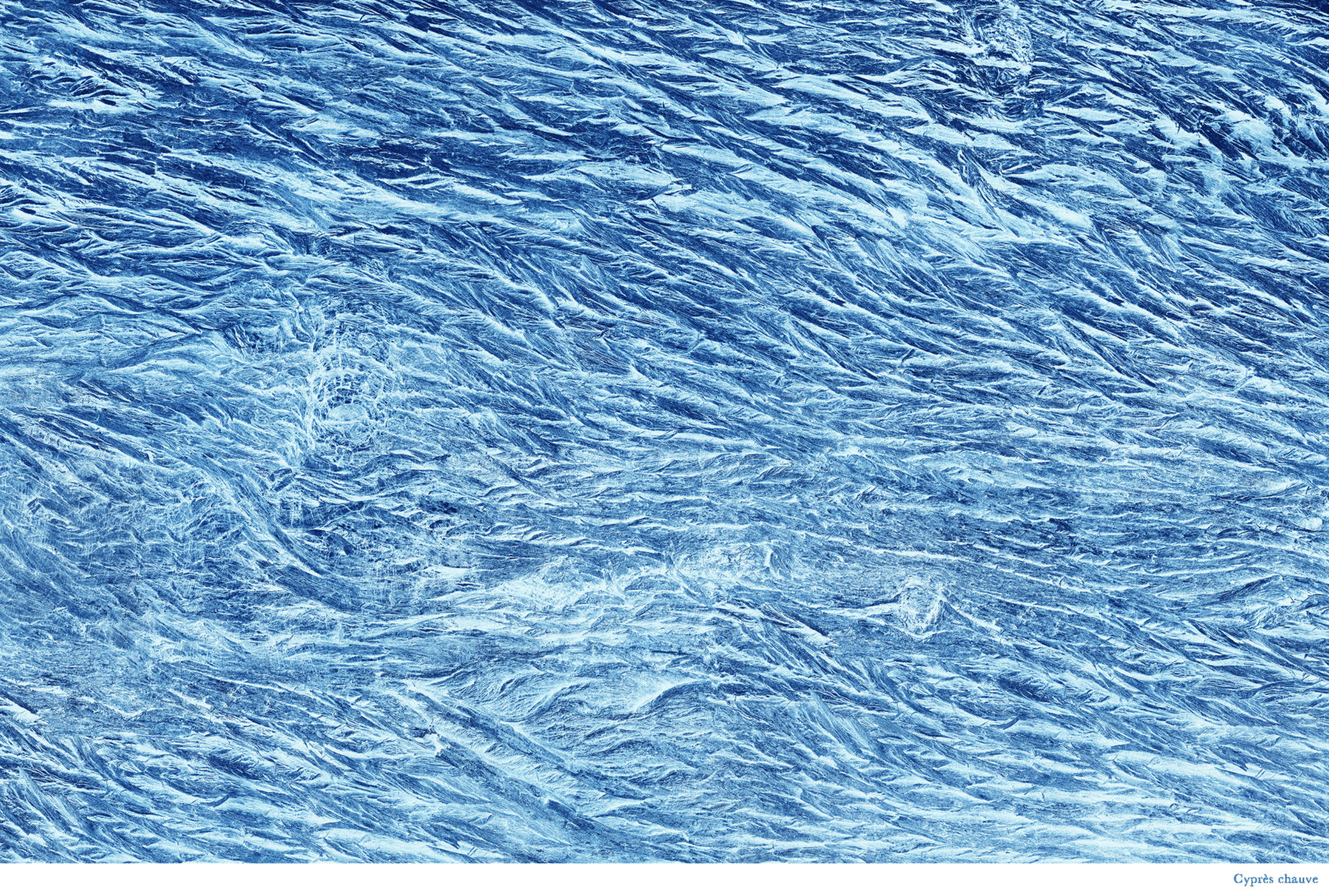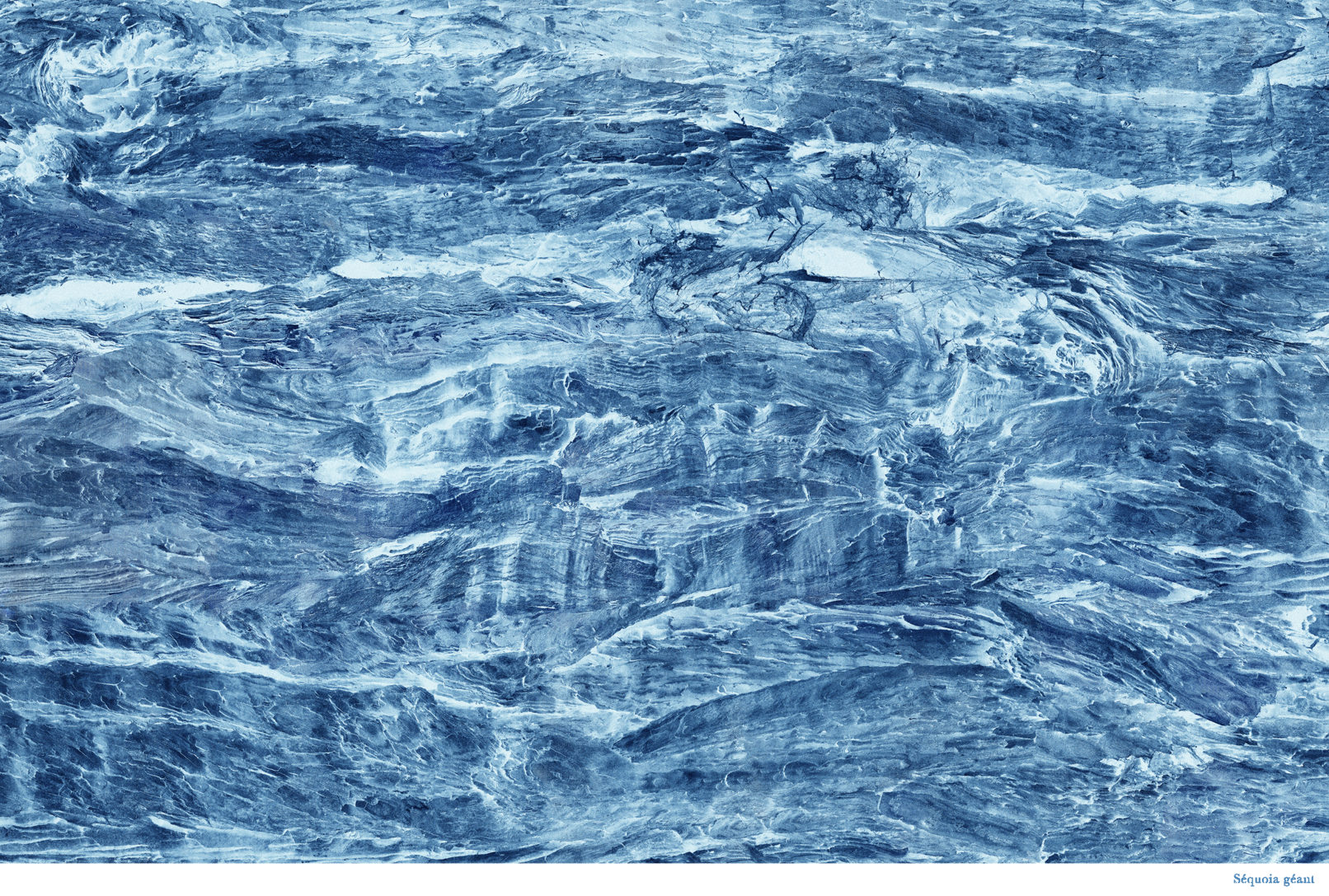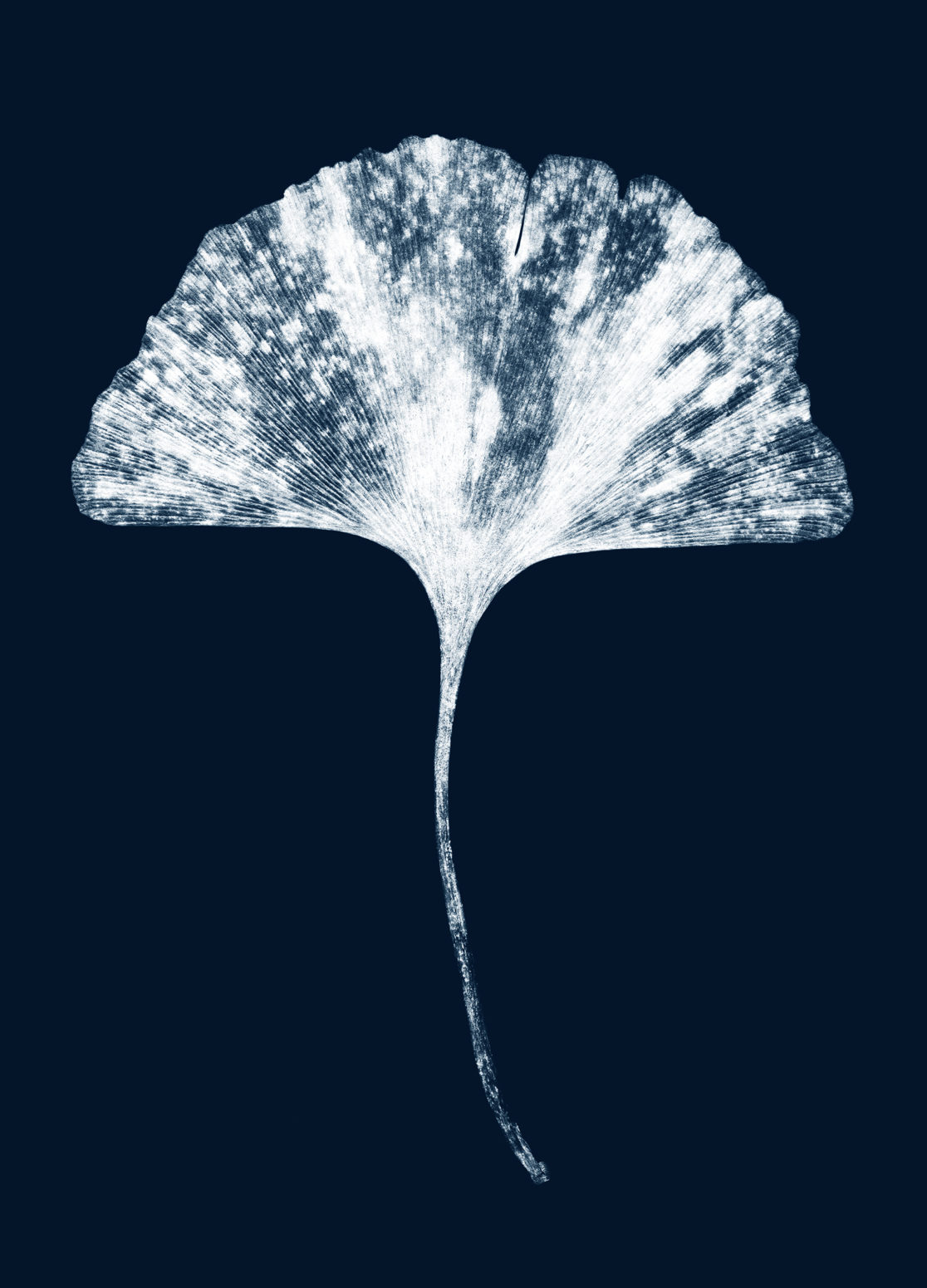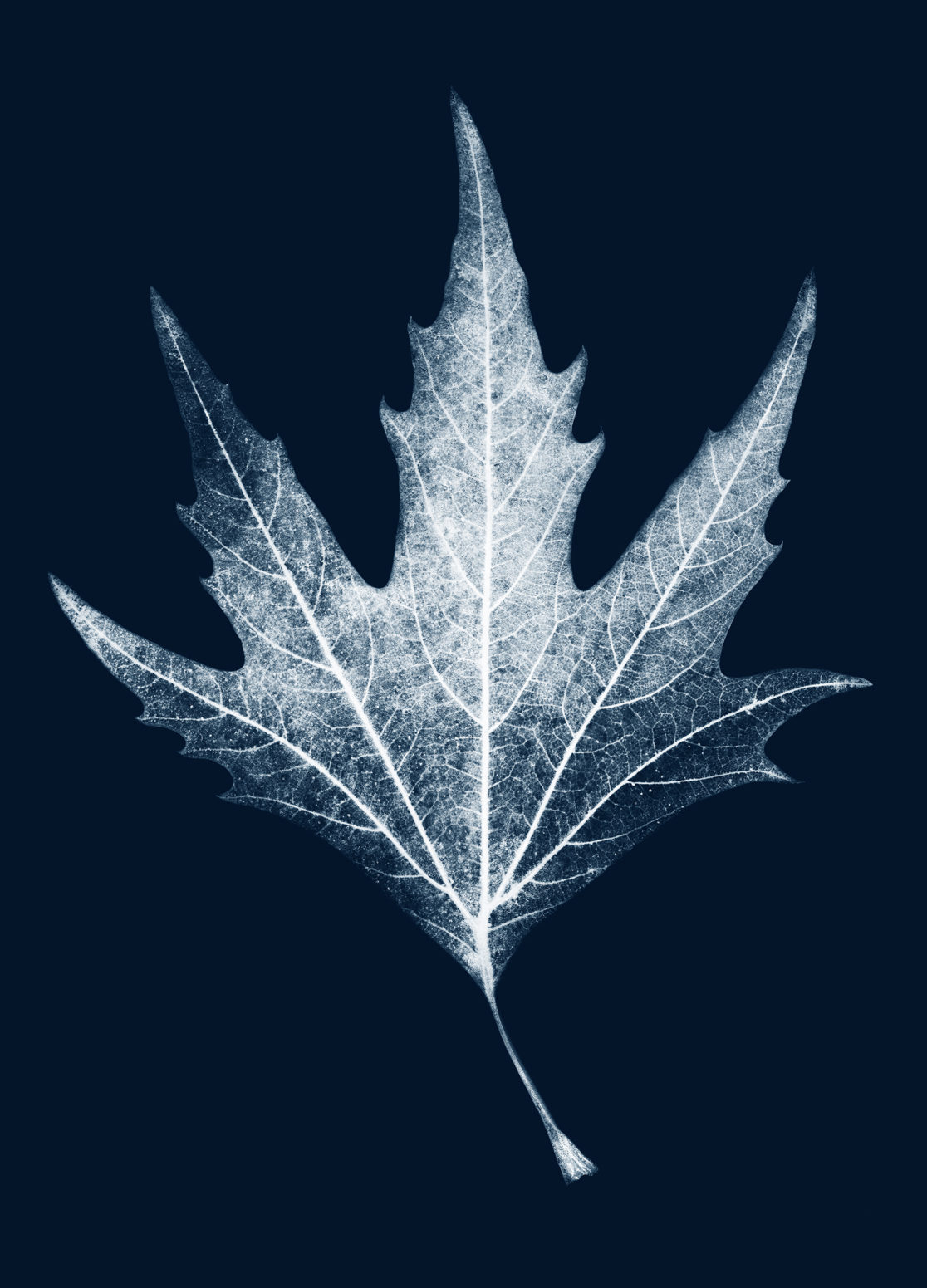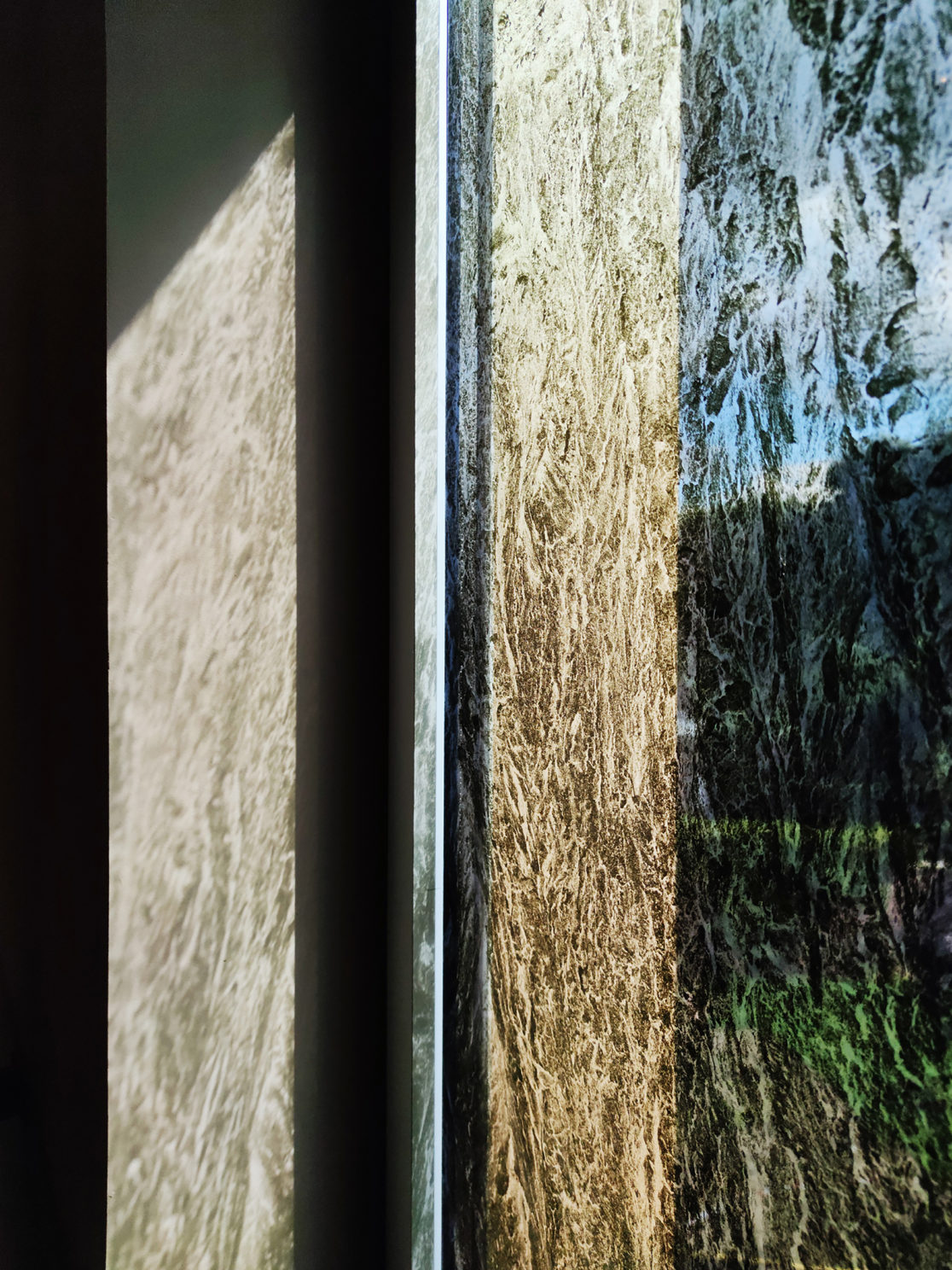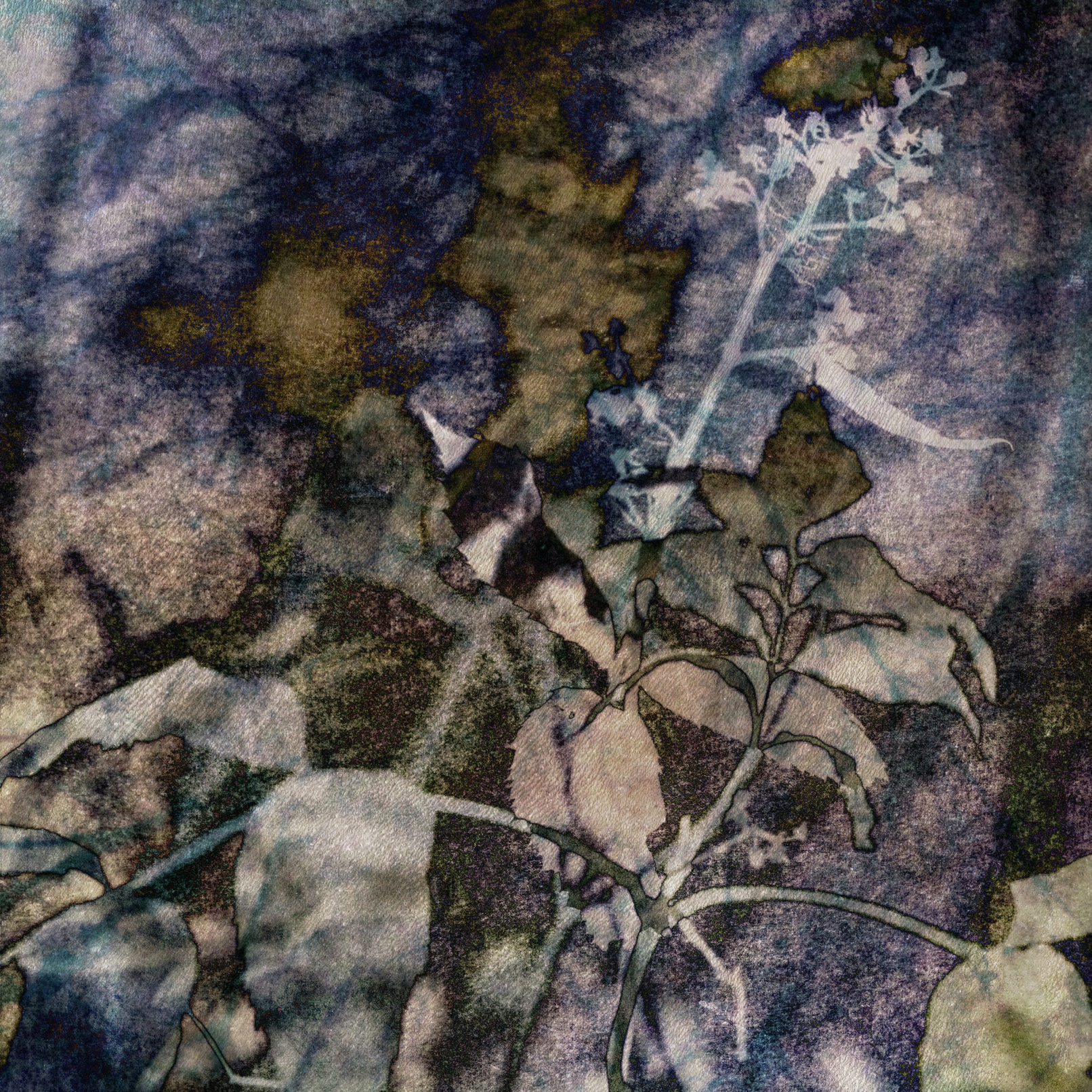ATLAS
2021 (artistic commission for the Jean Arnault campus, in collaboration with Le Fresnoy)
Named Atlas, this exhibition was created specifically for the campus Jean Arnault in the historic building of the Ferret Savinel. The different photographic processes used by the artist for this project are a tribute to the first experiments in image fixation that cross the history of photography. The use of these techniques is the starting point of broad research on the question of memory, impermanence and the passage of time. What is the relationship between the image represented and the materials that compose it? How can a photographic image reflect its environment?
Water, tree leaves, moss, brick, and concrete dust were collected on the site for a process of metamorphosis. These elements are integrated into the very material of the image or fixed in the form of imprints on various supports, from glass to silk to cotton paper. Macro photographs of different tree barks invite us to change the scale to explore the surface of these centennial plant bodies like an atlas.
Through the different techniques used, the images, projected or printed, will constantly vary according to their exposure to sunlight, in resonance with the campus. Images of the morning, the day, and the evening. Images reflecting the variations of nature and the nearby Barbieux park, which itself changes with the days and seasons. The artist’s will is to offer to the students and faculty, who will be present on the campus every day, constantly renewed visions.
Atlas invites us to rethink the paradox of the first photographic images, before the discovery of the fixated image, where sunlight caused both the appearance and disappearance, and where brevity produced in return mental images and memories in the viewer.
Production supports:
L’EDHEC
Groupe LVMH
Le Fresnoy – Studio national des arts contemporains
MusVerre, Sars-Poteries
Médiathèque de Roubaix
Archives municipales de la ville de Roubaix
GLASTINT
UH5
TCHIKEBE
Ébéniste
Fibracreativa
ATLAS #1
2021
2 four-color UV prints on ultra-transparent film laminated on glass
323 x 1092 cm (1st floor) / 228 x 454.6 cm (4th floor)
Exposed on the windows of the entrance, the first artwork of the exhibition offers the viewer a journey between micro and macro. Is it a microscopic view or the topography of an unknown landscape?
Several close-up views of the bark of a cedar tree have been assembled to form a composite image. This composition was transferred to paper using the Anthotype technique, a photographic print obtained from plant pigments. The artist used a moss called Sphagnum collected in Barbieux Park as well as leaves collected from the branches of the photographed cedar as pigments, giving the image this particular green tint.
Scanned, the result was then printed on a transparent paper that allows the play of light and reflections, and creates a connection between interior and exterior, between architecture and environment. This vegetal atlas functions as a mirror to the presence of the photographed cedar, located nearby close to the entrance.
On the 4th floor, the close-up photograph of a bark of the cherry tree was made using the same process and printed with plant pigments from the cherry tree, located just next to the cedar tree of the campus.
ATLAS #2
2021
1 gum bichromate print on BFK Rives Noir 280g paper mounted on aluminum, concrete dust from the campus, 44 x 65 cm
2 gum bichromate prints on BFK Rives Noir 280g paper mounted on aluminum, brick dust from the house, 44 x 33 cm
These prints are the result of a photomontage of several photographs representing two buildings, the Ferret Savinel, now the EDHEC campus, and the family home nearby.
Mixing photographic shots, archival images, and 3D views, the resulting image is thus an evocation of the memory of these spaces rather than a faithful representation. The prints were made with gum bichromate, an old technique that gives the images an evanescent and very pictorial texture. Concrete and brick dust collected on site was mixed with the pigments. The image of these buildings appears on the paper thanks to the very material of which their walls are composed. The dissolution of the excessive material reveals the blurred volume of the architectures, as if emerging from the mists of memory. By using this ancient photographic technique, the artist seeks a way to make the passage of time visible.
ATLAS #3
2021
2 research tables
65 x 200 x 85 cm
All of the artworks presented throughout the building are linked to these research tables which explain the corpus of works and their production process, in relation to archives linked to the history of Barbieux Park.
ATLAS #4
2021
6 silver prints with iron toning, digital print on silk
130 x 200 cm
On the upper floors, facing the windows, six prints of tree bark belonging to century-old trees from Barbieux Park are printed on silk so thin that it is transparent: Ginkgo, Metasequoia, Bald Cypress, Weeping Willow, Weeping Beech, Giant Sequoia.
An homage to the textile background of the city of Roubaix, this project also echoes the experiments of Elizabeth Fulhame, a forgotten Scottish chemist who played a crucial role in the history of photography. At the end of the 18th century, she was interested in dyeing textiles with gold and silver exposed to light. Attacked by the sun and oxygen, the colors showed variations over time. In a reinterpretation of this process, the artist applies iron toning to the silk prints, a chemical treatment to give the print a dominant color - in this case blue.
The chemical reaction continues over time, the color evolving over the days like a living organism, becoming darker. Each image is thus unique, echoing the metamorphoses of nature.
“I found the invention was applicable to painting and would also contribute to facilitate the study of geography; for I have applied it to some maps, the rivers of which I represented in silver, and the cities in gold.” - An Essay on Combustion, with a view to a new art of dying and painting, Elizabeth Fulhame, 1794
ATLAS #5
2021
Light installation with 4 glass plates and programmed spotlight
Installation : 245 x 500 cm, plate : 18 x 24 cm
The fragile silhouettes of Sycamore Maple, American Red Oak, Marsh Oak and Magnolia leaves collected in Barbieux Park have been sealed in glass plates. The transparent capsules in which they are now imprisoned emphasize the fragility of these hundred-year-old trees, now threatened by pollution. Burned by the process of glass fusion, the delicate veins of the leaves have fossilized, to the point of becoming white at the highest point of heat. Their shadows are projected on the wall using a lighting program.
For this installation, the artist was inspired by the research of Thomas Wedgwood and Humphry Davy, pioneers in the experimentation of photography. These two researchers recommended observing photographic images very rapidly and in the dark, by candlelight. Since the methods of permanently fixing images on a support had not yet been discovered at the time, any extended exposure to sunlight risked making the image fade forever.
“The copy of a painting, or the profile, immediately after being taken, must be kept in an obscure place. It may be examined in the shade, but, in this case, the exposure should be only for a few minutes; by the light of candles or lamps.”
- An Account of a method of copying paintings upon Glass and of making Profiles by the agency of Light upon Nitrate of Silver, Thomas Wedgwood & Humphry Davy, 1802
ATLAS #6
2021
Light installation with 4 serigraphs in photochromic ink on BFK Rives 270g paper, mounted on acid-free featherboard
75 x 105 cm
Imprints of Ginkgo, Metasequoia, Catalpa and Sugar Maple leaves, obtained through a combination of scans and photograms, are printed using a photochromic ink. The pigments in this ink react to the intensity of light. Almost transparent in the shade, their coloring is immediately revealed at the first light on the surface of the paper. In this reversible process, the images disappear and reappear under the action of a UV light that imitates the sunlight filtered through the foliage.
The artist revives the first photographic experiments of scientist William Henry Fox Talbot, initiated before the discovery of a method of fixated images. Fleeting and changing, they are alike to ghostly projections.
“The first kind of objects which I attempted to copy by Photogenic Drawing were flowers & leaves, either fresh or selected from my herbarium.” - The Pencil of Nature, William Henry Fox Talbot, 1844
ATLAS #7
2021
16 lambda prints on KODAK Duraclear film
53 x 177 cm / 53 x 195 cm / 53 x 231 cm
These macro photographs of the tree bark from the hundred-year-old trees of Barbieux Park are obtained by a combination of Anthotype technique, a photographic print from Sphagnum moss pigments, and silver-digital prints. Placed on the windows, they create a link with the entrance of the building. They rhythm the stairway, color the surfaces, and offer another view of the campus landscape.
ATLAS #8
2021
4 inkjet prints on Hahnemühle Photo Rag Satin 310g paper mounted on aluminum
80 x 80cm
Through these images, the artist’s desire to make the process of the image appearance an accumulation of temporal layers is manifested once again.
Like a goldsmith, he thus comes to sculpt the photographic material step by step. The initial technique used here is that of the polaroid print, whose image appears after 15 minutes. From this first image, the artist develops a whole series of back and forth between silver and digital practices, experimenting with many techniques: imprints of plants on the polaroid paper, digital scans, scratching of the polaroid paper, prints on polaroid from a smartphone, shooting of the printed image with a cell phone, etc.
Each step of the process adds complexity to the initial image and brings a new layer of visual information. As a result, some vegetal silhouettes are still recognizable, but the material of the image, the light leaks, and the traces of scratching on the surface of the polaroid paper appear. Like a palimpsest, these images crystallize the linked relationship between plants, light and photographic processes in the phenomena of the appearance of an image.










